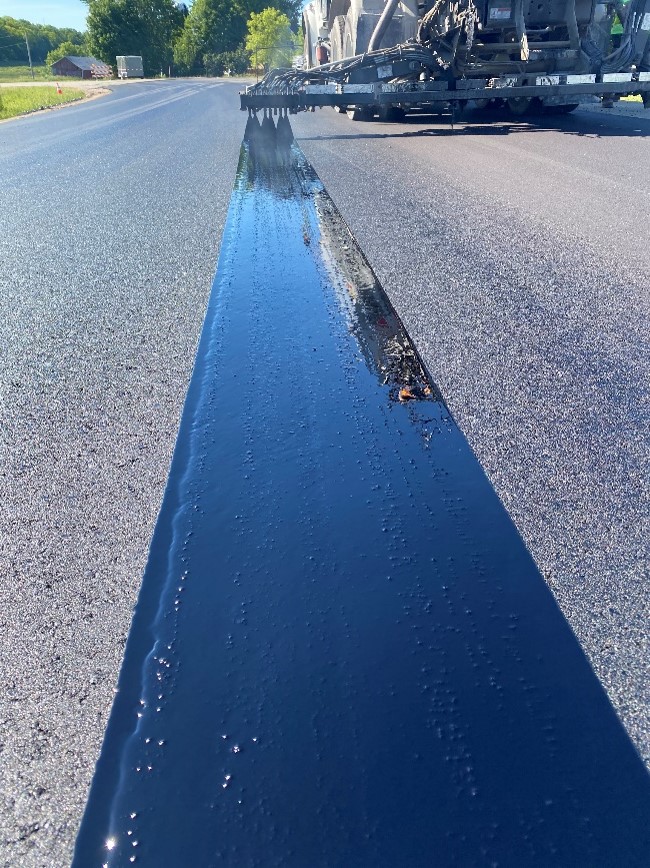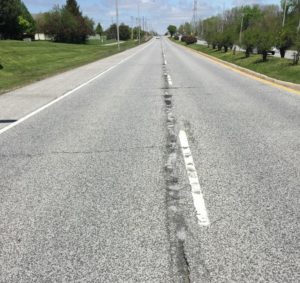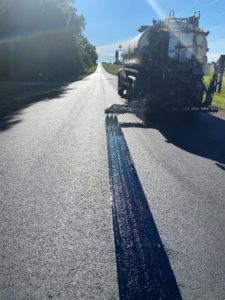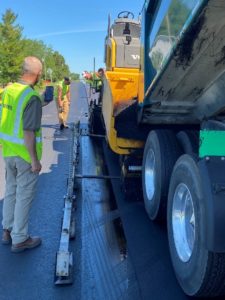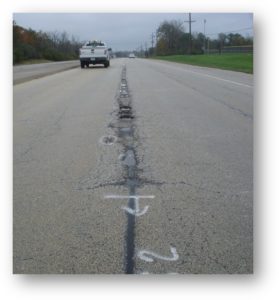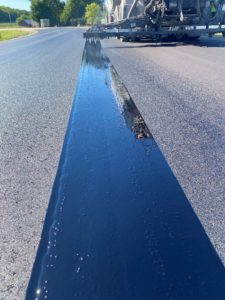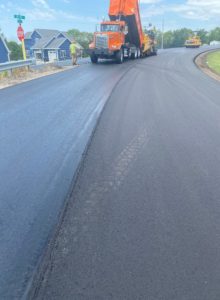Many states are looking for methods to improve longitudinal joint performance of their pavements, since these joints often fail before the rest of the surface. With the inherently lower density at the longitudinal joints we often see pavements fail by cracking, raveling, and potholing. Lower density is synonymous with higher air voids which leads to premature failure of pavements due to intrusion of air and water. Studies have shown that longitudinal joints in pavements are often the weakest areas of a road. (1)
A picture of a road’s longitudinal joint with significant damage.
Several state DOTs (Department of Transportation) are now using a materials approach to seal the longitudinal joint region by filling these air voids with asphalt content from the bottom up. This particular materials approach is referred to as VRAM(2), a Void Reducing Asphalt Membrane. VRAM is a highly polymer-modified asphalt cement that is placed at the location of a longitudinal joint before paving. As mix is paved over it, the VRAM melts and migrates up into voids in the low-density mix, making the mix impermeable to moisture while sealing the longitudinal joint itself.
Think of this materials approach and application as putting VRAM down first (asphalt content), to fill air voids in the HMA mat, AFTER the HMA has been placed. This is the innovative nature and chemistry of VRAM and why it has been helping roads last longer in more than 20 states in the United States.
This particular project covers 10,560 feet in Calumet County, Wisconsin from US 151 to Honeymoon Hills Road.
Illinois Department of Transportation (IDOT) test pavements were evaluated after 12 years and found to have longitudinal joints that exhibited significantly better performance than the control joint sections and were in similar or better condition than the rest of the pavement. Laboratory testing of cores showed decreased permeability and increased crack resistance of mix near joints with VRAM as compared with similar mix without VRAM. The life extension of the joint area is approximately 3–5 years, and the benefit is calculated to be three to five times the initial cost.
You will note the test section (above the white line) did not use VRAM, while the section below did use VRAM. This picture is from 15 years AFTER the VRAM was placed under the HMA at time of construction.
The crew started at address N3362 in the eastbound lane. Ambient temperature was 61F and existing pavement was 80F. ProTack applied a straight and consistent line throughout the project. VRAM width was measured with an average of 18 inches. (3)
This picture above shows an 18 inch application of VRAM.
The paving crew started at 11:40. Paving equipment consisted of a Volvo P7170B paver, Sakai SW850-II – 12-ton breakdown roller and a Volvo DD25B-5-ton finish roller. Width was 12 feet. Mix temp was 275F under the screed. HMA is placed over the VRAM. The heat and pressure of the HMA cause the VRAM material to migrate upwards 50-75% into the HMA, filling voids with asphalt content.
J-Band® is a VRAM product from Asphalt Materials, Inc. and was created in the labs of the Heritage Research Group.
J-Band has been helping roads last longer since 2002. VRAM has been used in 20 states and the District of Columbia.
Notes:
- Materials Approach to Improving Asphalt Pavement Longitudinal Joint Performance. National Academy of Sciences: Transportation Research Board 2021 Article: https://doi.org/10.1177/03611981211044451
- Editor’s Notes: VRAM, Void Reducing Asphalt Membrane is referred to in Illinois as LJS, Longitudinal Joint Sealant.
- Depending on the situation VRAM can be sprayed at different width’s. This article notes 18” which is a typical application width for centerline applications.

